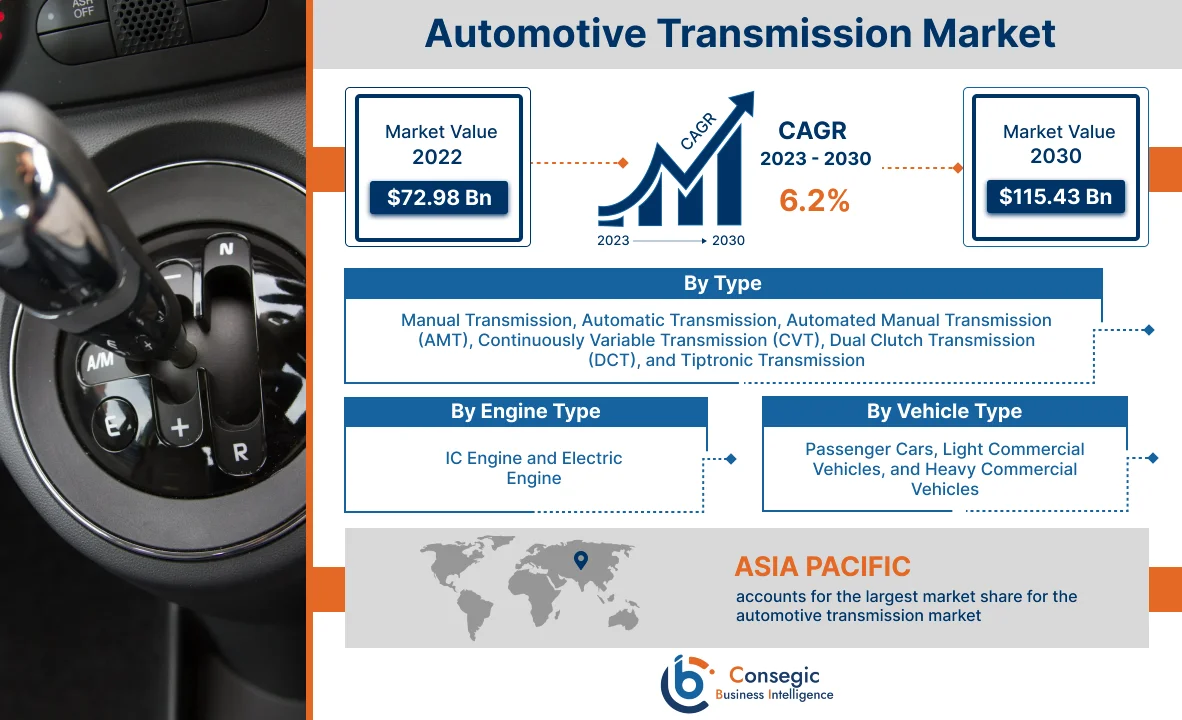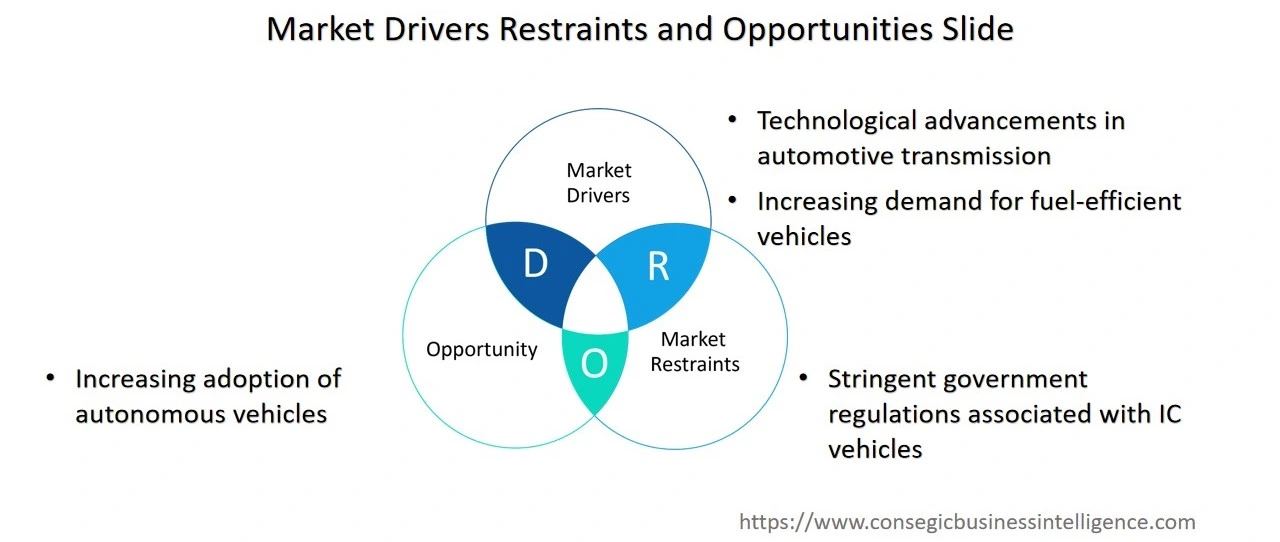Global Automotive Transmission Market Size :
Automotive Transmission Market size is estimated to reach over USD 115.43 Billion by 2030 from a value of USD 72.98 Billion in 2022, growing at a CAGR of 6.2% from 2023 to 2030.
Automotive Transmission Market Scope & Overview:
Automotive transmission is a mechanical or hydraulic system in a vehicle that transfers power from the engine to the wheels, allowing the driver to control the speed and direction of the vehicle by using different gears. The transmission works by varying the gear ratio between the engine and the wheels, depending on the driving conditions, such as speed, terrain, and load. The two most common types of automotive transmissions are manual and automatic, but there are other types of transmission also namely Continuously Variable Transmissions (CVT) and Dual-Clutch Transmissions (DCT).
Automotive Transmission Market Insights :
Automotive Transmission Market Dynamics - (DRO) :
Key Drivers :
Technological advancements in automotive transmission
The advancements in the technology of automotive transmission such as electrification are one of the key factors driving the market. Electric vehicles use a single-speed transmission or a direct drive system that provides a seamless power delivery experience without changing gears. Additionally, some hybrid electric vehicles use a planetary gear transmission that combines electric motors and a gasoline engine to provide power to the wheels. The transmission improves fuel efficiency and overall performance by managing the power flow between the engine and electric motors.
- For instance, in May 2022, Eaton announced to supply the new four-speed medium-duty electrified vehicle transmission to Proterra. The transmission is designed specifically for use in medium-duty electric commercial vehicles, to increase efficiency and improve the performance of the vehicles.
Increasing demand for fuel-efficient vehicles
The increasing demand for fuel-efficient vehicles is another major driving factor for the market. Automotive transmissions play a critical role in improving fuel efficiency by optimizing the engine's delivery power to the wheels. In addition, automotive companies are also investing in the development of more advanced transmission systems that offer better fuel efficiency and lower emissions.
- For instance, in May 2022, ZF introduced the EcoLife CoachLine transmission system, designed to improve the fuel efficiency and overall performance of buses and coaches. The transmission system features a new torque converter that provides better efficiency and reduced fuel consumption by up to three percent,
Thereby, the market trends analysis shows that the aforementioned factors are bolstering the automotive transmission market growth.
Key Restraints :
Stringent government regulations associated with IC vehicles
Strict government regulations on the use of IC vehicles and emission standards act as major factors restraining the market. The push towards zero-emission vehicles is reducing the demand for traditional transmissions, hindering the market.
- For instance, in August 2022, the California government implemented strict emissions standards namely the Advanced Clean Cars II rule, and also promoted the growth of zero-emission vehicles.
Consequently, the analysis of market trends suggests that the growth of zero-emission vehicles is lowering the demand for automotive transmission thereby impeding the automotive transmission market demand.
Future Opportunities :
Increasing adoption of autonomous vehicles
The development of autonomous vehicles is anticipated to create potential future opportunities for the market. Autonomous vehicles are expected to be more fuel-efficient than traditional vehicles, as autonomous vehicles are programmed to optimize driving behavior for maximum efficiency. Transmissions that are designed to work with electric and hybrid drivetrains further improve fuel efficiency, by providing better power delivery and reducing energy losses during gear changes. The increasing demand for autonomous vehicles is, therefore, projected to create lucrative automotive transmission market opportunities.
Automotive Transmission Market Report Insights :
| Report Attributes | Report Details |
| Study Timeline | 2017-2030 |
| Market Size in 2030 (USD Billion) | USD 115.43 Billion |
| CAGR (2023-2030) | 6.2% |
| Base Year | 2022 |
| By Type | Manual Transmission, Automatic Transmission, Automated Manual Transmission (AMT), Continuously Variable Transmission (CVT), Dual Clutch Transmission (DCT), and Tiptronic Transmission |
| By Engine Type | IC Engine and Electric Engine |
| By Vehicle Type | Passenger Cars, Light Commercial Vehicles, and Heavy Commercial Vehicles |
| By Geography | Asia-Pacific, Europe, North America, South America, Middle East & Africa |
| Key Players | Suzuki Motor Corporation, ZF Friedrichshafen AG, Hyundai Motor Company, Eaton Corporation plc, Tata Motors Limited, Lotus Cars Limited, Magna International Inc., JATCO Ltd, Aisin Seiki Co., Ltd., Allison Transmission, Inc. |
Automotive Transmission Market Segmental Analysis :
By Type :
The type segment is classified into Manual Transmission, Automatic Transmission, Automated Manual Transmission (AMT), Continuously Variable Transmission (CVT), Dual-Clutch Transmission (DCT), and Tiptronic Transmission.
Manual transmission dominates the market in 2022 in the total automotive transmission market share as manual transmissions offer greater control over the vehicle's performance. Manual transmission allows the driver to shift gears at their discretion for more precise control over the vehicle's speed and acceleration, especially for performance-oriented vehicles, such as sports cars. Moreover, manual transmissions are more fuel-efficient than automatic transmissions owing to the fewer internal components that are lighter than automatic transmissions, which reduce energy losses and improve fuel economy.
- For instance, in June 2020, Hyundai launched a new Intelligent Manual Transmission (iMT) technology in its Venue compact SUV, designed to offer convenience with the control of the manual transmission. The iMT system is equipped with a 'creep' function that allows the vehicle to move forward slowly without using the accelerator pedal, offering convenience to driving in heavy traffic.
The aforementioned factors, including improved performance and fuel efficiency, are contributing significantly to the automotive transmission market growth.
Dual Clutch Transmission (DCT) is expected to register the fastest CAGR in the automotive transmission market as DCTs offer superior fuel efficiency and smoother shifting than traditional automatic transmissions. The increasing importance of fuel efficiency and reduced emissions in the automotive industry is further driving the market. Additionally, the growing adoption of DCTs in high-performance vehicles to allow faster acceleration and higher top speeds is also promoting the automotive transmission market demand. Moreover, DCTs are designed to shift gears much faster than traditional automatic transmissions, allowing the engine to operate more efficiently and deliver more power to the wheels.
- For instance, in March 2022, Tata Motors launched the ALTROZ DCA with a Clutch Automatic transmission to offer superior performance, fuel efficiency, and reliability. The integration of DCT technology enables fast gear changing that improves fuel efficiency and also enhances the user experience.
Consequently, the segmental analysis concludes that the ability of DCTs to offer high performance and superior fuel efficiency are among the key factors that are projected to drive the automotive transmission market trends during the forecast period.
By Engine Type :
The engine type segment is bifurcated into Internal Combustion (IC) engines and electric engines.
IC engines dominate the market in the overall automotive transmission market share by offering high power and torque outputs, becoming ideal for a wide range of driving conditions, including high-speed driving, towing, and off-road driving. The high power is especially true for larger vehicles, such as trucks and SUVs, where the power and torque of an IC engine are necessary to carry heavy loads or navigate through rough terrain. Additionally, IC engines are relatively affordable and have a well-established infrastructure for fuel distribution and maintenance. The aforementioned factors including high power and torque outputs contribute collectively to driving the automotive transmission market trends.
- For instance, in July 2021, Lotus launched the EMIRA sports car with three transmission options, including a manual transmission, automatic transmission, and dual-clutch transmission, with an internal combustion engine. The inclusion of multiple transmissions improves the torque output and also provides an enhanced driving experience.
Therefore, the analysis of segmental trends suggests that the aforementioned factors are promoting the growth of the automotive transmission market.
Electric engines are anticipated to register the fastest CAGR in the automotive transmission market during the forecast period. The growing adoption of EVs increases the demand for electric engines which is expected to drive the market in upcoming years. Additionally, electric vehicles offer a range of benefits over traditional gasoline or diesel-powered vehicles, including reduced emissions, improved fuel efficiency, and lower operating costs. Furthermore, the advancements in electric motor technology, battery technology, and power electronics are also driving the automotive transmission market expansion.
Moreover, the increasing focus by the governments on reducing emissions and achieving sustainability goals is also contributing significantly to propelling the surge of electric engines. In conclusion, the ability of electric engines to reduce carbon emissions and improve fuel efficiency is expected to drive the market in the upcoming years.
- For instance, in January 2023, Suzuki Motor Corporation collaborated with Inmotive Inc. to develop a 2-speed EV transmission for the Suzuki electric vehicle. The collaboration aims to develop electric vehicles having improved efficiency, faster acceleration, and increased top speed.
Thus, the segmental trends analysis suggests that the aforementioned factors are contributing significantly to driving the automotive transmission market opportunities.
By Vehicle Type :
The vehicle type segment is trifurcated into passenger cars, light commercial vehicles, and heavy commercial vehicles.
Passenger cars dominate the market and are also expected to witness the fastest CAGR during the forecast period. Passenger cars require a wide range of transmission options including manual, automatic, CVT, and DCT to meet the demand for different driving conditions, performance requirements, and customer preferences. Additionally, passenger cars are more affordable than other types of vehicles, such as commercial trucks and buses. The accessibility of automotive transmissions at an affordable price leads to the expansion of the customer base and results in increased sales volumes, thereby driving the market.
- For instance, in November 2022, according to the India Brand Equity Foundation (IBEF), the Indian passenger car market was sized at USD 32.70 billion in 2021 and is expected to reach a value of USD 54.84 billion by 2027, by witnessing a CAGR of over 9% between 2022-27.
Thus, the segmental trends analysis suggests that the growth in sales of passenger vehicles is, therefore, expected to increase the demand for automotive transmissions in upcoming years.
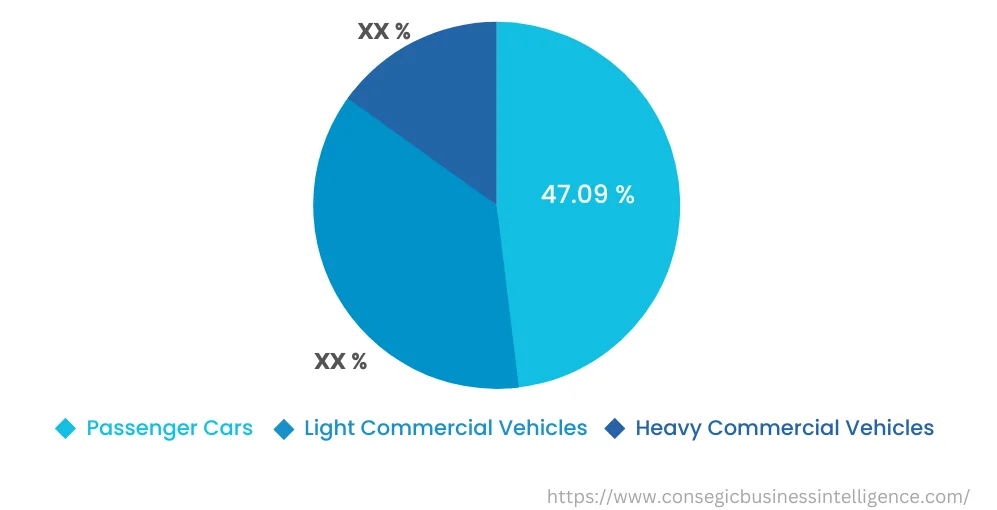
By Region :
The regional segment includes North America, Europe, Asia Pacific, the Middle East and Africa, and Latin America.
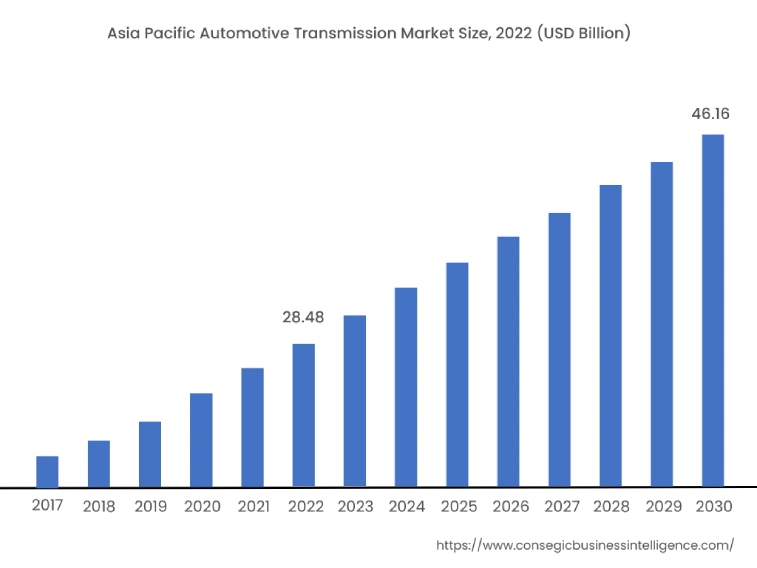
Asia Pacific accounts for the largest market share in 2022 valued at USD 28.48 Billion with a CAGR of 6.5% during the forecast period and is also expected to witness the fastest CAGR during the forecast period. The automotive industry in Asia Pacific is characterized by a high degree of manufacturing efficiency and cost competitiveness. The above-mentioned factors enable manufacturers in the region to produce vehicles and components at lower costs than their counterparts in Europe and North America. Additionally, Asia Pacific encompasses a large number of transmission component manufacturers who are constantly developing advanced technologies and manufacturing capabilities to hold the market position.
Moreover, the regional trends analysis shows that the automotive manufacturers supply transmission components to both domestic and international automakers, further facilitating market expansion in the region.
- For instance, in July 2021, Jatco Ltd. launched CVT-X, for medium to large FWD vehicles that improve environmental performance and drivability. CVT-X has 90% transmission efficiency to transmit power from the engine to the wheels with minimal energy loss, improving fuel efficiency and reducing emissions.
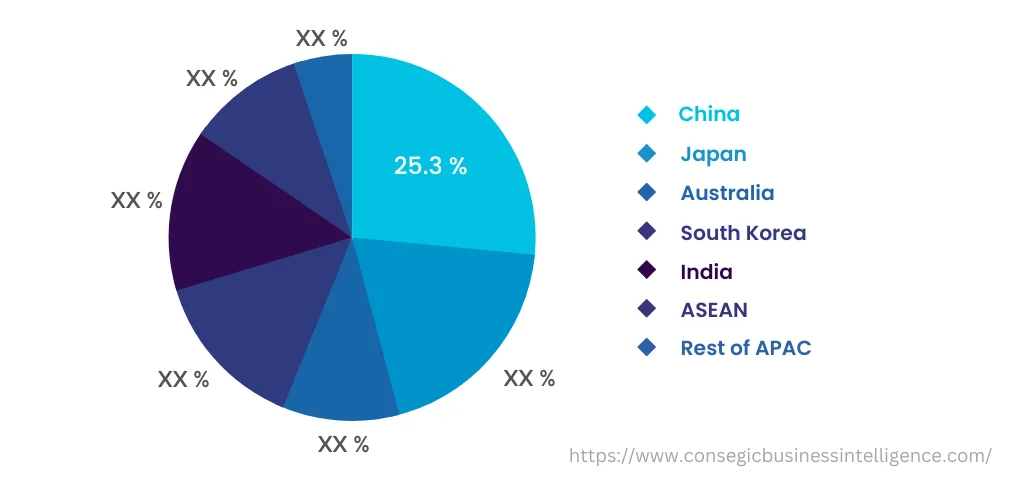
Top Key Players & Market Share Insights:
The global automotive transmission market is highly competitive, with many established players and new entrants competing for market share. The competitive landscape of the market is characterized by intense competition, with many established players and new entrants vying for market share. The key players in the market are constantly innovating to improve the efficiency and performance of the transmissions and are focused on expanding their global footprint to capitalize on growth opportunities in emerging markets. Some of the key players in the automotive transmission industry include -
- Suzuki Motor Corporation
- ZF Friedrichshafen AG
- Hyundai Motor Company
- Eaton Corporation plc
- Tata Motors Limited
- Magna International Inc.
- JATCO Ltd
- Aisin Seiki Co., Ltd.
- Allison Transmission Holdings Inc.
- Lotus Cars Limited
Recent Industry Developments :
- In April 2021, ZF announced to invest USD 200 million in the expansion of its North American commercial vehicle transmission manufacturing. The investment will drive the growth of automotive transmission technology in the region and enable the company to meet the increasing demand for its products.
- In December 2020, LG Electronics and Magna International entered a joint venture agreement to expand their presence in the powertrain electrification market. The collaboration is expected to expand LG's presence in the automotive industry and also provide Magna with access to cutting-edge technology and expertise in the electric powertrain market.
Key Questions Answered in the Report
What is automotive transmission? +
Automotive transmission is a mechanical component in a vehicle that transmits power from the engine to the wheels, enabling the vehicle to move. The transmission works by converting the rotational power generated by the engine into torque, which is then used to turn the wheels.
Based on current market trends and future predictions, which geographical region will have the largest impact on the automotive transmission markets growth in the coming years? +
According to the current market trends and future predictions, Asia Pacific will have a major impact on the growth of the automotive transmission market owing to the expanding automotive industry. Also, the region encompasses key players that constantly develop advanced technologies and also supply transmission components to international automakers.
What specific segmentation details are covered in the automotive transmission market report, and how do each dominating segment is influencing the demand globally? +
The report consists of segments namely Type, Engine Type, and Vehicle Type. Each segment consists of a dominating sub-segment segment fuelled by industry trends and drivers. For instance, By Type, manual transmission accounts for the largest market share owing to improved performance and fuel efficiency.
What specific segmentation details are covered in the automotive transmission market report, and how is the fastest segment anticipated to impact the market growth? +
As aforementioned, each fastest segment is influencing the demand globally due to growing industrial needs. For instance, By Engine Type, electrical engines sub-segment is anticipated to witness the fastest CAGR growth during the forecast period offering several benefits including reduced emissions, improved fuel efficiency, and lower operating costs.
